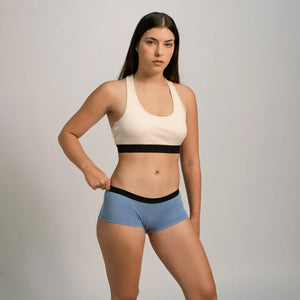Polyester: From Petroleum to Microplastics
AYA | AUGUST 30,2022
Now that science has confirmed the presence of microplastics in our bloodstream, it is necessary to know the responsibility that fast fashion has in it. Only when we understand how plastic is made, and how the use of synthetic clothing contaminates our blood with plastic particles, we will be able to make a change.
Matter from Millions of Years Ago
To begin with, it is essential to define that "Plastic" is a term that describes a malleable material made from polymers that can be easily molded into different objects. It can be manufactured synthetically, through chemical processes, and organically, through natural components like lactic acid from sugar.
Thus, synthetic plastic (from now on “plastic”) originates from two fossil fuels: crude oil and natural gas. They receive this category because they can release energy (fuels) and are the product of organic matter from millions of years ago (fossils).
These fossils, sedimented in very deep layers of the earth, were subjected to high pressure and temperatures for millennia until they became matter with unique chemical characteristics. These characteristics give plastics its diverse benefits, but at the same time, its great sin: the inability to degrade after being chemically processed.
This last point will be vital for understanding its contaminating effect, so we will return to it later.

Petroleum Pumpjack
Petroleum as Raw Material
Since crude oil and natural gas share the exact nature and follow an equivalent process, we will use the term "petroleum" to refer to both from now on.
Petroleum is extracted and processed in refineries to obtain, among other substances: Petroleum Gas (LPG), Gasoline, Kerosene, Diesel and Naphtha. From Naphtha we get Ethylene, Xylene, and Propylene, 3 determining compounds in the generation of plastic.
On one hand, catalysts are added to Ethylene and Propylene to join their molecules and convert them into polymers: Polyethylene and Polypropylene. The "Poly" in their names indicates that they now form long, flexible chains of chemical compounds that can be molded under pressure and heat, that is, plastic in its purest form.
But specifically, Ethylene and Xylene give rise to the compound of our interest: Polyethylene Terephthalate, better known as "PET." This is the material from which the famous plastic bottles are made, as well as the fibers of synthetic garments.

©ILO Asia-Pacific via Flickr
That is why bottles can be "recycled" to make clothes, resulting in an action that is not truly sustainable, as we will see later.
According to the Textile Exchange report, plastic fibers are used to make 62% of all textiles, 52% of which is Polyester and the remaining 10% is Polyamide, Acrylic, or Elastane (you may also know it as Nylon, Lycra or Spandex).
From PET to “Polyester”
PET and Polyester are actually the exact same materials, but "Polyester" is the common name used for this compound in the textile industry.
The process begins with PET chips being melted into long, thin fibers, to which petrochemicals are often added to make them more functional. Then, these fibers create films that are cut to obtain their industrial form: "Polyester staple fibers." As you can see, it has a similar shape to cotton or other textiles.
From here, Polyester can be mixed with other fibers to create blends, such as “30% cotton, 70% polyester”. These fibers are processed to become thinner and to be grouped in Cones of Polyester Yarn, the kind you already find in craft stores.
These polyester yarns are knitted, washed, dyed with petrochemical dyes, and treated with petrochemical finishings to generate a finished fabric. This fabric is where the clothes are finally made, usually sewn with polyester or nylon threads, to which labels of the same material are added.
Finally, we have obtained synthetic garments ready for sale. And as if that were not enough plastic, these garments are usually packed in bags of such material.
Releasing Microplastics
Here we come to the critical question of the topic: How do clothes release microplastics?
Simply by its use. The fact of putting on clothes with synthetic fibers already begins to release these microplastics, just from their daily wear.

Synthetic Fibers
As for how much is released, we can find verified data at least at the ocean level: The most significant presence of primary microplastics results from washing synthetic clothing. In other words: synthetic clothing is the leading cause of microplastic contamination in water.
With this reference, we can intuit the strong presence of these particles in our daily environments. And it is because we are not only talking about those immediately released from our everyday objects but about those inserted into our food chain just by polluting our rivers and seas.
Why Are Plastics So Polluting?
As we pointed out at the beginning, the origin of plastics is from sedimentary fossils millions of years old endow it with unique chemical characteristics. However, being unique, they are no longer recognizable to the vast majority of microorganisms; consequently, they cannot digest them.
This is the reason why plastics are not biodegradable, and it is also the reason why their destiny will always be to become smaller and smaller plastic particles, barely visible to the human eye.
Now you understand why recycled plastic (e.g. Recycled Polyester) can be classified more as "greenwashing" than a sustainable action. Although recycling indeed helps reduce waste, recycled plastic products will continue to generate microplastics; the primary problem is still there.
Hence, it is not a question of betting on recyclable alternatives but of directly eliminating their use. Not using plastics is the most efficient way to combat microplastic pollution. And now that we know microplastics exist in our blood, not promoting the fast fashion industry is a critical first step.
That is exactly what we do at AYA: 100% plastic-free clothing, as we are committed to creating a healthier world for you and the environment. We invite you to spread the information about plastic fashion so that together we maintain our planet livable for future generations.
Visit Our Shop →You May Also Like to Read...
The Truth About Recycled Polyester in Fashion
Discover the hidden costs of recycled polyester. Learn why rPET isn't as sustainable as it seems and what real circular alternatives look like.
Synthetic Fabrics vs. Organic Cotton: Impact on Skin Health
Discover how polyester and other synthetic fabrics can irritate your skin and why organic cotton, especially Pima cotton, is a healthier and safer choice for sensitive skin.
What Peru Whispers: Organic Pima Cotton Grown with Tradition and Care
In the quiet corners of Peru, organic pima cotton is grown with respect for the land. A luxurious, timeless textile waiting to be discovered.
Why Sustainable Fashion Shouldn’t Be Fast Fashion
Recycled materials and green labels won’t fix fast fashion. Discover why real sustainability means slowing down.
















